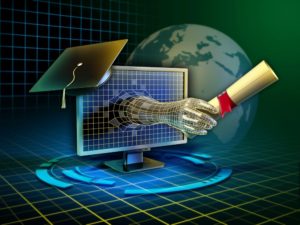
Distance Learning & Science Fiction
With many of our schools physically closed, and distance learning on the rise due to Covid-19, I thought it would be interesting to take a thought-journey into the worlds of computer educational systems as predicted by science fiction.
“Tape and Deep Tape” are used as a computer learning method in CJ Cherryh’s Alliance-Union Universe & Foreigner series: specifically the protagonist clone in Cyteen and the starship captains in the Foreigner books, especially Captain Jason Graham. This is not so much a computer learning model as it is a way of implanting difficult knowledge bases in an almost subliminal method.
In Cyteen, which is the name of a planet for those who have not read the book, a woman tries to create not just a physical clone of herself but an emotional replica. She uses Tape and other people to duplicate in her clone all of the same experiences she’s had. This is sinister in that she’s using computer learning to shape someone who is an actual individual unto herself.
It’s not sinister when, in Cherryh’s Foreigner book Precursor, Jason Graham is voluntarily “in the tank,” learning various technical things via Tape. During this he’s unavailable and completely involved in letting the computer implant the necessary knowledge to run a starship while he’s all but anesthetized. When he’s done, the difficult concepts are truly known by him on a very deep level.
Another example of online “learning” can be found in the fix-up novel Accelerando by Charles Stross – specifically in his novella “Lobsters.” Cynically, Stross’ character Manfred Mancx doesn’t so much learn as have knowledge on tap due to a pair of high-tech eyeglasses that give him knowledge without learning. In fact, it’s the AI which knows and has been configured to give Manfred the knowledge that he needs to cut his subversive deals. It’s divorced from him actually learning to the point where Manfred is lost without his wired eyeware – and a street orphan thief who steals the glasses almost takes his place.
I hope that’s not where we are headed, and I think neural implants are pretty far off in our future. For an example of what I hope the nearer future holds, in Anne McCaffrey’s Talents series there is something called “Teacher.” This method of schooling is specifically used by the character Tirla in Pegasus in Space – the bridge novel between McCaffrey’s Talents series and her Tower and the Hive series. It’s a beautifully pre-imagined teaching method, and “pre-imagined” is my own term for when I think a science fiction writer guesses correctly about an aspect of future technology. I’m fairly certain this is where we are eventually headed, which is part of why I (rather than follow in the footsteps of a long line of educators in my family) did not become a teacher back when I was choosing a career. Centralized online learning was how I took many of my college courses as early as 1973. It’s very inexpensive compared to a traditional classroom and just like email versus paper letters, I think economics will dictate that it will eventually replace all but must-do-in-person studies of things such as chemistry labs, dissections, martial arts, or cooking and tasting the results.
McCaffrey’s “Teacher” is an online resource you log into who lets you progress at your own speed but also gives you a good background and basic overall education. It’s presented as a mixture of recorded resources run by an AI program with a human-looking avatar and voice. In Pegasus in Flight Tirla had an illegal, unregistered birth and logged onto Teacher illegally, posing as her legally-born brother from after he died until the system figured out he was dead. Once she gets a new and legal identity she’s almost a compulsive learner in Pegasus in Space. As she puts it, “I gotta keep in touch.”
Pegasus in Space also introduces us to Amariyah, a Talented orphan who comes from Bangladesh where she received in-person schooling from the nuns who ran an orphanage. When she is adopted by the Northeastern Parapsychic Center, Teacher conducts assessment tests and then starts her on the next phases of appropriate learning. As we follow Amariyah to her eventual career, we see that at a young age Teacher allows her to take college-level courses in the things that fascinate her (gardening and then hydroponics and medicine), just as long as she takes all of the prerequisites. I especially like the fact that the human touch is not removed from this method of teaching because the parents or guardians have input and help guide it. And kids are encouraged to play with other children.
But of all the examples of future learning I’ve read one stands out to me as relevant as to how schools are shifting to online learning due to the pandemic. In the 1960’s Isaac Asimov wrote a short story called “The Fun They Had.” (Read it here: https://lewebpedagogique.com/anglais/wp-content/blogs.dir/16/files/the-fun-they-had.pdf)
In this tale two grade-school children find an old paper book in an attic and marvel at the very concept of what school used to be in ancient days: kids actually went into a classroom with other kids and learned at desks from flesh-and-blood human teachers. It seems inconceivable to the youngsters, and they wistfully wish that they could experience it.
The bottom line? Computers may standardize basic learning courses, but we must remember that children need to play, and need the socialization of other kids the same age. They need guidance, and you cannot just blindly throw knowledge at them without the wisdom to use it well. As regards the field of future learning methods, the cautionary tales of science fiction have much to teach us.
– Wendy S. Delmater
